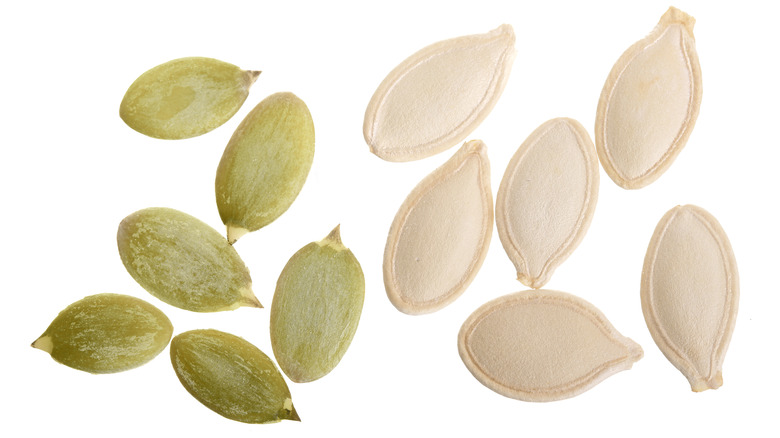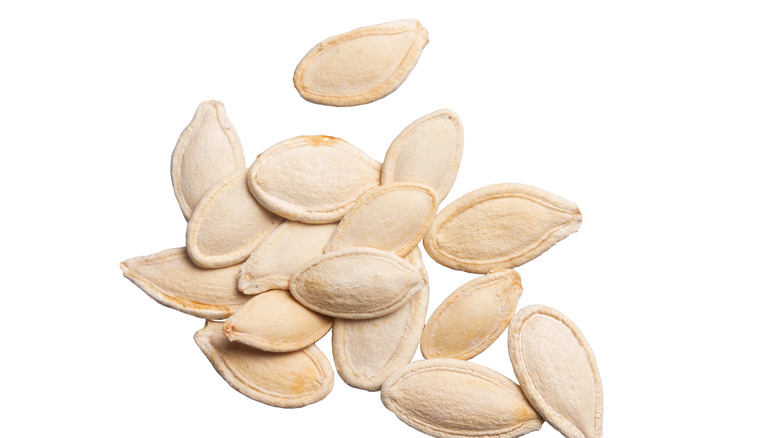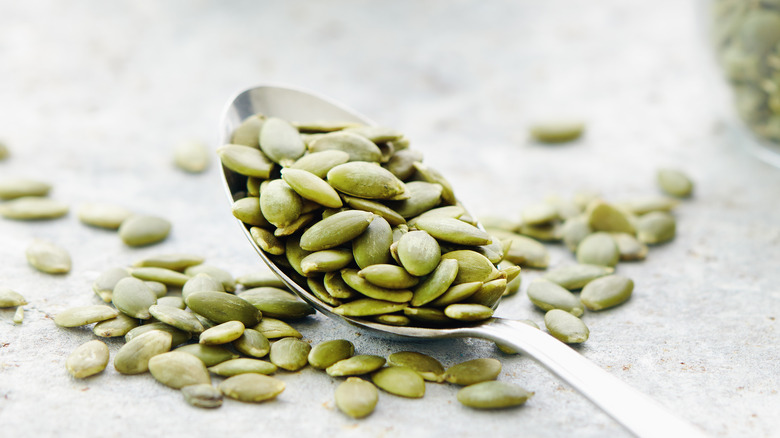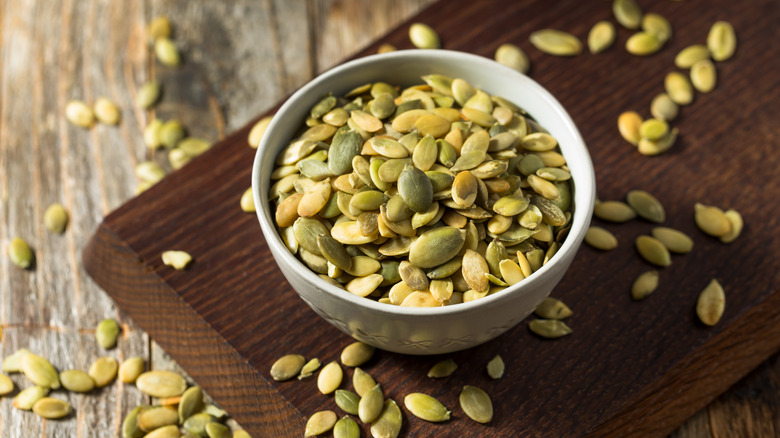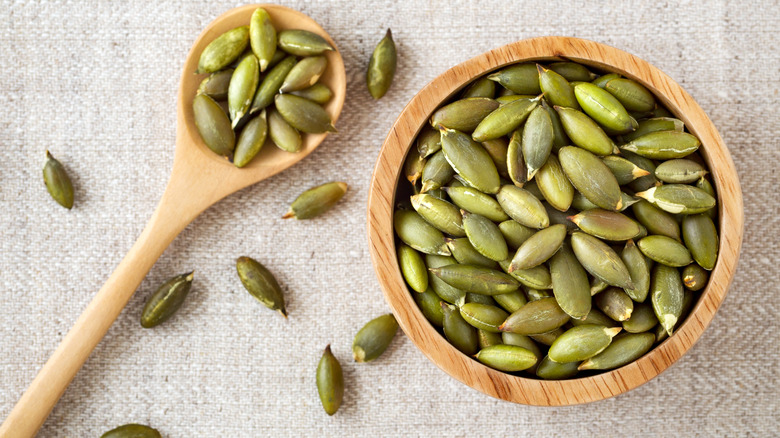Pepitas Vs Pumpkin Seeds: What's The Difference?
When you want to add some crunch to your salad or homemade trail mix, you might consider throwing in a handful of pepitas or pumpkin seeds. Doing so could have benefits, including some added fiber, magnesium, and even tryptophan, which may help you sleep better at night, according to Healthline.
But if you're at the grocery store trying to decide between the two seed varieties and wondering, 'aren't they the same thing?', you're pretty close.
To some extent, both pumpkin seeds and pepitas are the same — and often used interchangeably. Both are found inside pumpkins, and though pepitas can also be the term for the treasure hidden inside those white, chewy pumpkin seed casings (like sunflower seeds), it turns out pepitas have their own category all to themselves. As Organic Agriculture Centre of Canada explains, pepitas are naturally shell-free and come from special varieties of oilseed pumpkins like the Styrian type grown in Austria.
In other words, don't expect to cut open your Jack-O-Lantern and find a treasure trove of those yummy green kernels you got in a bag at the health food store. Despite these small differences, though, both seeds make for a great addition to any diet.
What are pumpkin seeds?
Sourced straight from the insides of the squash, pumpkin seeds are flat, teardrop-shaped, and whitish-yellow kernels with protective shells around them. Much like sunflower seeds, this outer casing is technically edible both raw or cooked, though many people prefer to roast the seeds with salt to make them more palatable. Even then, others prefer cracking open the shell solely to get to that precious morsel on the inside.
While you could let your teeth do all the work and spit out each hull as you gnaw on your bag of pumpkin seeds, if you're looking for a method to get rid of the shells that is slightly less messy (and less bothersome to anyone around you), one author at My Recipes has a tip: Put the seeds between some wax paper, and gently pound them with a mallet to crack open the shell. Just be careful not to hit them too hard so you don't destroy the seeds on the inside. The end result won't taste identical to a pepita you buy from the store, but it will be pretty tasty on its own.
No fancy kitchen mallet? No problem. Edible Tapestry shares that you can de-shell the seeds by running them under a rolling pin or boiling them until the casings slide off naturally.
What are pepitas?
A pepita, which gets its name from the Spanish word for "little seed of squash" (via Nutstop), is an oval-shaped green seed without a shell around it. Unlike regular pumpkin seeds, which have a fibrous, bland hull, raw pepitas are smooth and nutty, with a just a hint of natural sweetness. As such, they make excellent toppings for desserts and savory dishes alike, including pumpkin bread, soup, salad, oatmeal, yogurt, a granola bar, or a smoothie. They're particularly used in Mexican dishes as they are a cultural cornerstone of that region, eaten as far back as the time of the Aztecs, says Nutstop.
Because they also come from pumpkins, it's a common to assume that pepitas are merely pre-shelled pumpkin seeds — perhaps a creation invented by the food industry out of a desire for convenience, like ready-to-eat hardboiled eggs or pre-chopped veggies. In fact, many recipes on the web use the words interchangeably.
But Slate points out this is actually a misconception, as pepitas actually come from very specific varieties of pumpkins that produce only shell-free seeds. This is why the pepitas sold in stores don't taste the same as the pumpkin seeds you might roast around Halloween.
Pepitas and pumpkin seeds are both nutrient-dense
Don't let their small size fool you: Both pumpkin seeds and pepitas are packed with a ton of nutrients. Per Healthline, in addition to containing a solid dose of zinc, which may support immune system function, pumpkin seeds boast a high concentration of iron that helps with blood circulation. Both are also a great vegetarian source of omega-3 alpha lipoic acid (ALA), which is usually found in fish. Even better, these seeds are a rich source of antioxidants, which have been linked to lowering the risk for certain types of cancers. Because of these health benefits, pumpkin seeds are often regarded a "superfood," among the likes of kale, flaxseeds, salmon, and papaya.
While both pumpkin seeds and pepitas are nutrient-dense, you may want to think twice before passing on the ones with shells for the smoother pepitas. Also according to Healthline, a serving of whole pumpkin seeds with the shells on contains 5 grams of fiber, which is double what you get with pepitas. Since consuming fiber daily has been shown to promote healthy digestion and good gut bacteria, it may be worthwhile to keep both the shelled and unshelled varieties on hand to get the most benefits.
Can you use pumpkin seeds and pepitas interchangeably?
Both pumpkin seeds and pepitas are described as having a slightly oily, nutty flavor, which makes them a great allergy-friendly alternative in recipes that call for nuts. However, despite these similarities, the two seeds often serve different culinary purposes. The crunchy, teardrop-shaped pumpkin seeds with the hulls on are commonly roasted and eaten as a standalone snack whereas pepitas are frequently added to soups, sauces, salads, granola bars, and other recipes.
As a result, it's not exactly an even exchange when it comes to swapping these seeds for one another. But, to minimize the confusion, one good rule of thumb to follow is to remember that while all pepitas are pumpkin seeds, not all pumpkin seeds are pepitas. In other words, the green kernels can totally be used as a stand-in for snack mixes that call for the regular seeds. But when it comes to the reverse, this where exercising your best judgment comes in hand. You probably wouldn't want to add regular pumpkin seeds with those fibrous shells to your smoothie or pesto sauce, but when it comes to using them as a garnish or as a crunchy addition on a fall charcuterie board? Feel free to swap away.
